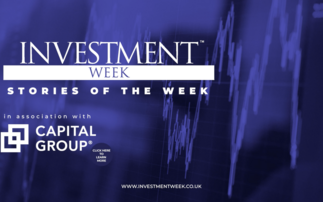Lacklustre European economic growth has scared off many investors but Fidelity's Colin Stone believes value can be found in companies that offer robust sales and profits growth with the ability to generate cash
Fidelity's Colin Stone is convinced that having exposure to European companies can provide handsome rewards for investors - even though many advisers are cautious about the region because of concerns over levels of economic growth.
The manager of the £522m Fidelity European Opportunities fund says the combination of world-leading companies and attractive stock valuations provide a very compelling argument for investing in Europe.
And while he acknowledges the lack of consumer confidence that has resulted in mediocre rates of GDP growth across many countries, Stone is adamant that the positives still far outweigh the negatives.
"The core of Europe is not the most dynamic growth region in the world but it also gets a fairly bad press in the UK," he says. "Many people underestimate the diversity of economic growth within Europe. While it is true that growth in Germany and France has been lacklustre, regions such as Greece, Spain and Ireland have provided very attractive levels of growth over the last three to four years."
As is quite often the case, an uninspiring economic outlook does not necessarily translate into poor market returns. "Equity markets in Europe are by no means expensive," Stone adds.
"When you consider 10-year bond yields are now less than 4%, I think the PE multiples on European stocks are extremely attractive. Europe offers investors a very broad stock market with tremendous scope for adding value by stock selection. There are many leading global companies which are based in Europe."
The Fidelity European Opportunities fund, which is benchmarked against the FTSE World Europe ex UK Index, was launched in September 1988. It aims to deliver long-term capital growth from an actively managed portfolio of companies listed in continental Europe.
Finding the most attractive of these growth stories before they become common knowledge is a crucial element of Stone's investment process. The more stars of tomorrow he can spot, the greater his chances of enjoying success.
"I'm looking to identify companies with an attractive, high growth profile early in their life cycles before they become widely known by other investors," he explains. "That is the core of my investment philosophy."
To this end Stone will often search for companies which are leaders in niche markets with strong competitive advantages. Under-researched companies with strong management teams whose profits have been driven by strong sales growth are also important, along with the ability to generate cash and an attractive valuation.
Stone has employed the same approach since he first began managing the fund in January 2003.
After assuming control, he embarked on a restructuring programme which saw around 60% of his predecessor's assets replaced.
"There were a number of very large individual holdings in companies," he recalls. "I decided to cut down the risk level, reduce a number of the individual bets and put my own stamp on the portfolio by introducing more small and mid-cap names."
This trend has continued. "I run a fairly concentrated portfolio and manage the fund without reference to benchmark weightings," explains Stone.
"I also ensure that the largest exposure is to companies in which I have built the highest conviction."
The size of companies is also important. Of the 80-90 stocks which make up the fund, around half are from the large-cap arena, while mid and small-cap companies each account for around 25% of the overall portfolio.
Stone remains confident that there are still plenty of opportunities to find good value names in mid and small caps, even though valuations have risen since the beginning of 2003, when they were at almost all-time lows. By historical standards, he points out, they are still appealing. Many of them are also capable of delivering further strong growth.
"Smaller companies are often the most interesting and most mis-priced but this is certainly not a small-cap-only fund," says Stone. "As well as the small and mid-cap ideas, I also have a good selection of large-cap names."
Stone's natural leaning towards growth-oriented stocks is, perhaps, the most significant difference between his approach and that taken by Tim McCarron, who manages the Fidelity European fund.
"It's true that I have more of a growth bias and Tim has more of a value bias," agrees Stone. "I'm looking to buy outstanding growth companies and the most important part of the investment process is finding those which can positively surprise."
However, growth stock investing is not just a matter of buying companies that can grow sales or earnings quicker than the market. Stone believes it is important to assess other factors such as a company's cash generation ability and its valuation. These factors help to provide a safety net when buying stocks on higher-than-average valuations. It's an interesting approach at a time when many investors are predicting a return to growth investing.
Managers who succeed in this area are the ones that find the most attractive quality companies across a range of criteria, Stone believes.
"Growth investing can be a hazardous pastime as the cost of failure is quite high," he says. "If these stocks disappoint then you will lose money on both the earnings downgrade and the valuation downgrade.
"On the flip side, there is the potential for great returns if you get the stock-picking right. Ideally you want to invest in companies which have the potential to give you a positive earnings surprise. Having good research is crucial to successful growth investing."
So how does Stone find his opportunities?
"Typically, the stocks in my portfolio are capable of generating double digit organic sales growth," he explains. "Ideally, this growth would be sustainable for several years."
Ideas will come from a number of different sources.
"It's a real mixture of in-house research, my own ideas and suggestions from brokers," says Stone. "I have a broad network of specialist brokers across Europe who are particularly helpful as far as small-cap companies are concerned."
The help provided by the in-house team, however, is the most important factor. "They are the secret of our success," insists Stone. "We have a 58-strong pan-European analyst team who all dig very deeply into the companies and the industries that they cover. A large part of our success can be attributed to them."
Stone cites fashion retailer Hennes & Mauritz - better known as H&M - as an example of a large-cap company that boasts the range of attributes he likes to see displayed within his portfolio.
The business, which was established in Sweden in 1947, now has well over 1,000 stores across 21 countries selling clothes and cosmetics, as well as more than 45,000 employees around the world.
"There are not that many interesting large-cap names in Europe but H&M is an example of a retail business which works well in numerous geographies and is still growing its market share," says Stone. "They have cheap sourcing, their stores are very productive, the profitability of the company is high and it generates a great free cashflow which comfortably finances its growth. I think that this will continue."
Further down the market cap scale, but equally impressive, is Nobel Biocare, which has a major presence in the field of dental solutions.
"The dental implant business is in its very early stages of growth worldwide and Nobel is the leader in this industry," says Stone. "It's gaining market share, has some great product launches and has enjoyed spectacular growth in earnings-per-share over the last five years. As long as the market and company continues to grow then there's no reason why the share price shouldn't continue rising."
So when does Stone decide to sell a holding? "When a stock has done well I consider whether it's because the valuation multiple has expanded - which means it's just become more expensive - or if earnings and profitability have been growing," he explains. "If the earnings estimates are being upgraded then I'm happy to hold on for a bit longer."
Often, he adds, the sell trigger may occur when a better idea presents itself. "I'm continually testing new ideas against existing holdings in the fund," says Stone. "They need to be strong enough to push out existing names."
By the nature of his approach, Stone finds he is typically overweight in certain sectors.
"I have had a significant overweight in healthcare for the past couple of years," he says. "In this industry we are finding a lot of very attractive growth companies which I don't think are particularly cyclical."
In contrast, he has an underweight position in financials. "I don't have great exposure to the western European banks because I am finding better ideas elsewhere," he says. "Also, if the economies slow down, then the banks will be badly hit because they are highly leveraged businesses."
It's an investment approach that clearly works very well.
Over the past year Stone has achieved a bid-to-bid return of 16.6% - compared with the 11.0% average achieved by the Europe Excluding UK sector - according to data compiled by Standard & Poor's up to 2 May this year.
This ranks the fund within the top decile. Over Stone's tenure, the fund is also top decile, producing a return of 53.5% compared with just 37.6% for the sector average, ranking the fund sixth out of 94.
"The performance that the fund has delivered over the last couple of years has been generated by getting a lot of individual investment decisions right," Stone says. "There haven't been one or two stocks or themes which have dominated. It has all been down to superior research - it's very much a bottom-up process."
Recently, Stone's achievements have been given credit by S&P which has awarded his portfolio an A-rating in recognition of both his investment process and the performance figures achieved.
The S&P report highlighted Stone's focus on quality growth companies with strong franchises in which there is a strong likelihood that future earnings will exceed consensus expectations.
It also commented on the "significant amount" of personal research undertaken by Stone and the aforementioned back-up and research support provided by Fidelity's team of analysts.
For anyone familiar with Stone's track record his achievements at the helm of the European Opportunities fund will come as no surprise.
His investment career started with Fidelity in 1987, where he began as an oil analyst before moving up the ranks to become a portfolio manager in 1990. As well as running a range of European mandates, he also supported Anthony Bolton in the management of his European portfolios. At the end of March 2005, the total amount of money under his management stood at £1.7bn.
Looking ahead, what does Stone expect to be the dominant issues over the coming months? "I have recently reduced my exposure to eastern Europe to lock in profits because the stocks I had in the portfolio had performed very well," he says.
"However, I still think it's an interesting area in the long term. There are still some good opportunities in this area although valuations have come up substantially," Stone adds. "What is happening now is a process of structural adjustments that will take place over a decade."
Europe, he maintains, is full of potential. As well as emerging companies there are still plenty of world leaders among the ranks which can be relied upon to deliver.
Whether growth in the core European economies rebounds or not, Stone remains confident that his stock-picking based investment approach can provide investors with strong returns.
"My long-term approach is to identify companies that are well positioned to provide robust sales and profits growth with the ability to generate cash."
"As long as I continue to find attractive growth stories in European markets, then I'm happy that investors in my fund will be well rewarded over the long term," he explains.












